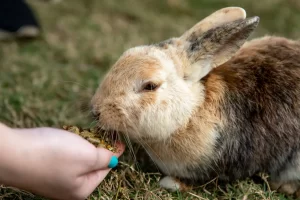Did you know that rabbits are naturally skittish animals and can easily become stressed when handled incorrectly? If you need to restrain a rabbit for grooming, medical procedures, or travel, it’s important to do it safely and without causing unnecessary stress.
In this article, you will learn the proper techniques and tools for safely restraining a rabbit in various situations. By following these guidelines, you can ensure the well-being of your furry friend while serving their needs.
In This Article
- 1 Key Takeaways
- 2 Understanding Rabbit Behavior
- 3 Proper Handling Techniques
- 4 Tools and Equipment for Safe Restraint
- 5 Restraint for Grooming and Nail Trimming
- 6 Restraint for Medical Procedures
- 7 Restraint for Travel and Transport
- 8 Restraint for Stressful Situations
- 9 Tips for Minimizing Stress During Restraint
- 10 Frequently Asked Questions
- 10.1 Can Rabbits Be Easily Trained to Tolerate Restraint?
- 10.2 How Often Should Rabbits Be Restrained for Grooming and Nail Trimming?
- 10.3 Are There Any Specific Tools or Equipment Recommended for Restraining Rabbits During Medical Procedures?
- 10.4 What Are Some Common Signs of Stress That Rabbits Exhibit During Restraint?
- 10.5 Can Rabbits Become Aggressive or Bite When They Feel Restrained?
- 11 Conclusion
Key Takeaways
- Observing rabbit behavior closely and recognizing communication cues is essential for understanding rabbit behavior and creating a comfortable environment for restraint.
- Proper handling techniques include approaching calmly and slowly, using two hands for support, keeping the rabbit close to the body, and speaking in a soothing tone.
- Using tools and equipment such as gloves and a towel, and considering natural instincts and behavior, is important for safe restraint.
- Restraint techniques for specific situations include using a gentle and firm grip for grooming and nail trimming, maintaining a gentle but firm grip for medical procedures, and introducing crate training or leash training for travel and transport.
Understanding Rabbit Behavior
You should observe your rabbit’s behavior closely to understand its needs and preferences. Rabbits communicate through various cues, such as body language and vocalizations. By paying attention to these cues, you can gain insight into what they’re trying to convey.
For example, if your rabbit thumps its hind legs on the ground, it may be signaling danger or a warning to other rabbits. Understanding territorial behavior is also crucial in meeting your rabbit’s needs. Rabbits are naturally territorial animals, and they mark their territory using scent glands located on their chins and feet.
Providing them with appropriate areas to mark, such as a litter box or designated play area, can help satisfy their territorial instincts. By recognizing and responding to these communication cues and territorial behaviors, you can ensure a happy and comfortable environment for your rabbit.
Proper Handling Techniques
To ensure the safety of the rabbit, always use two hands when picking it up and avoid any sudden movements. Rabbits can be easily startled, and sudden movements can cause them stress or injury. When handling a rabbit, it’s important to follow proper techniques to ensure their comfort and well-being. Here are four important tips to keep in mind:
- Approach the rabbit calmly and slowly, speaking in a soothing tone. This helps to build trust and reduce anxiety.
- Place one hand under the rabbit’s chest and the other hand supporting their hindquarters. This provides proper support and prevents them from wriggling out of your grasp.
- Keep the rabbit close to your body to make them feel secure. This also helps to prevent them from jumping or kicking.
- Avoid lifting the rabbit too high or dropping them from a height. This can cause injury or unnecessary stress.
Tools and Equipment for Safe Restraint
Using the proper tools and equipment, like gloves and a towel, can help ensure safe restraint of the rabbit during handling. Rabbit handling requires gentle and careful techniques to prevent injury to both the handler and the rabbit.
When restraining a rabbit, it’s important to consider their natural instincts and behavior. You should approach the rabbit calmly and confidently, avoiding sudden movements that may startle them.
Properly restraining a rabbit involves supporting their body securely and ensuring their limbs are safely immobilized. This can be achieved by gently wrapping them in a towel or holding them close to your body. It’s crucial to avoid putting excessive pressure on the rabbit’s delicate bones and organs.
Restraint for Grooming and Nail Trimming
Make sure to use a gentle and firm grip when restraining your rabbit for grooming and nail trimming. Proper restraint is essential to ensure the safety and comfort of your furry friend.
Here are some tips to help you with the process:
- Approach your rabbit calmly and confidently to reduce stress.
- Place one hand under their chest, supporting the front legs, and use the other hand to hold the hindquarters.
- Maintain a gentle but firm grip to prevent your rabbit from escaping or injuring themselves.
- Keep the rabbit’s head supported and secure to avoid any sudden movements.
When it comes to grooming techniques and nail trimming, remember to be patient and take it slow. Use the appropriate tools, such as a soft brush for grooming and a sharp, guillotine-style nail trimmer for trimming.
Always trim the nails carefully, avoiding the quick.
Restraint for Medical Procedures
When restraining your rabbit for medical procedures, it’s important to maintain a gentle but firm grip to ensure their safety and prevent any sudden movements.
Restraint for dental procedures and administering medication requires a careful approach to ensure the well-being of your furry friend.
For dental procedures, you can gently wrap your rabbit in a towel, leaving their head exposed. This allows the veterinarian to examine and treat their teeth while minimizing the risk of injury or escape.
When administering medication, it’s best to hold your rabbit securely, supporting their hind end with one hand and gently restraining their front legs with the other. This helps to keep them calm and prevents accidental injuries during the process.
Restraint for Travel and Transport
To ensure the safety of your rabbit during travel and transport, it’s important to securely fasten them in a carrier with proper ventilation and cushioning. Here are some tips to help you restrain your rabbit effectively:
- Crate training: Introduce your rabbit to a crate or carrier gradually by making it a positive and comfortable space. Use treats and toys to encourage them to enter and spend time in the crate.
- Leash training: Teaching your rabbit to walk on a leash can be beneficial for short trips or outdoor adventures. Start by getting them used to wearing a harness and then gradually introduce the leash, allowing them to explore their surroundings under your supervision.
- Proper ventilation: Ensure that the carrier or crate has adequate airflow to keep your rabbit cool and comfortable during travel. Avoid using carriers that are completely enclosed or made of materials that restrict airflow.
- Cushioning: Place a soft bedding material, such as a blanket or towel, in the carrier to provide your rabbit with a comfortable surface to rest on. This will also help absorb any accidents or spills that may occur during the journey.
Restraint for Stressful Situations
You can effectively manage stressful situations by calmly and confidently practicing restraint. When it comes to handling aggressive rabbits, it’s important to prioritize your safety and the well-being of the rabbit. Here are some effective restraint techniques for handling aggressive rabbits:
| Technique | Description | Benefits |
|---|---|---|
| Scruffing | Gently grasping the loose skin on the back of the rabbit’s neck | Provides control and immobilizes the rabbit |
| Towelling | Wrapping a small towel around the rabbit’s body, leaving only the head exposed | Calms the rabbit and prevents biting or scratching |
| Bunny burrito | Wrapping the rabbit snugly in a towel or blanket, leaving only the head and limbs free | Provides a secure and comforting restraint |
When introducing rabbits to new environments, it’s important to minimize stress and ensure a smooth transition. Here are some restraint strategies for introducing rabbits to new environments:
| Strategy | Description | Benefits |
|---|---|---|
| Slow introduction | Gradually introduce the rabbit to the new environment, starting with a small, safe space | Reduces stress and allows the rabbit to adjust at their own pace |
| Scent swapping | Rubbing a cloth on one rabbit and placing it near the other rabbit’s living area | Helps familiarize the rabbits with each other’s scent before physical interaction |
| Controlled socialization | Supervised, controlled interactions between rabbits, gradually increasing their time together | Promotes positive socialization and reduces the risk of aggression |
Tips for Minimizing Stress During Restraint
If you’re looking for tips on minimizing stress during restraint, it’s important to remember that creating a calm and quiet environment can greatly help in keeping the rabbits relaxed. Here are four calming techniques and strategies to create a safe environment for the rabbits:
- Provide a comfortable space: Make sure the rabbits have a clean and spacious area where they can feel secure. This can be achieved by using soft bedding and ensuring proper ventilation.
- Minimize noise and distractions: Loud noises and sudden movements can startle rabbits, so try to keep the area as quiet as possible. Close doors and windows, turn off the TV or radio, and avoid unnecessary conversation during the restraint process.
- Use gentle handling techniques: When restraining a rabbit, it’s important to handle them with care and avoid any rough movements. This includes supporting their body properly and avoiding any unnecessary pressure.
- Offer positive reinforcement: Rewarding rabbits with treats or praise after successful restraint can help create positive associations and reduce stress. This will make future restraint experiences easier for both the rabbits and the handlers.
Frequently Asked Questions
Can Rabbits Be Easily Trained to Tolerate Restraint?
Restraint can be challenging, but rabbits can be trained to tolerate it. By using gentle handling techniques and positive reinforcement, you can teach your rabbit to feel more comfortable and secure during restraint.
How Often Should Rabbits Be Restrained for Grooming and Nail Trimming?
For grooming and nail trimming, it is recommended to restrain rabbits regularly. The ideal frequency varies, but once or twice a month is a good starting point. To minimize stress, handle the rabbit gently and use positive reinforcement.
Are There Any Specific Tools or Equipment Recommended for Restraining Rabbits During Medical Procedures?
When it comes to restraining rabbits during medical procedures, it is important to have the right tools and equipment. Specific recommendations include using gentle restraints and handling techniques to ensure the safety and comfort of the rabbit.
What Are Some Common Signs of Stress That Rabbits Exhibit During Restraint?
When restraining a rabbit, it’s important to recognize common signs of stress like panting and struggling. Training can help rabbits tolerate restraint, but it’s best to minimize how often they need to be restrained for grooming and nail trimming.
Can Rabbits Become Aggressive or Bite When They Feel Restrained?
When feeling restrained, rabbits may exhibit aggression or bite. To calm a stressed rabbit during restraint, try gentle handling, providing a secure and quiet environment, and using soothing techniques like soft talking or offering treats.
Conclusion
In conclusion, while restraining a rabbit may seem challenging, understanding their behavior and using proper handling techniques can make the process easier and safer.
It’s important to remember that rabbits are sensitive animals, and minimizing stress during restraint should always be a priority.
By following the tips and techniques outlined in this article, you can ensure the well-being of your rabbit and create a positive and stress-free experience for both of you.





